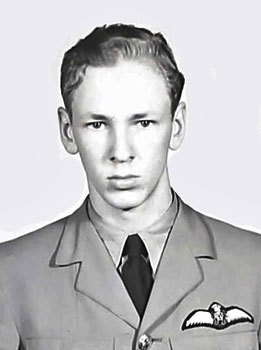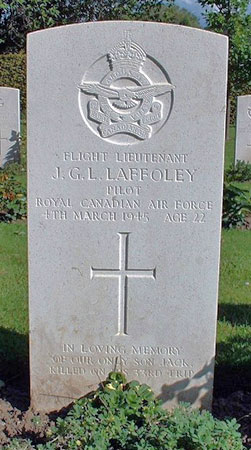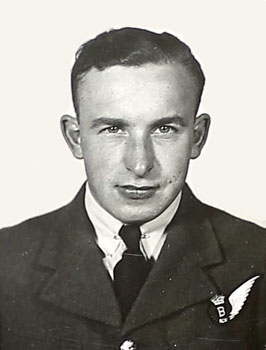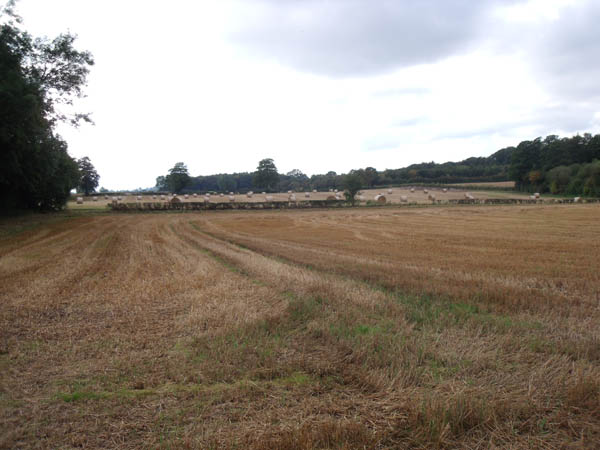Halifax HX332 at Spellow Hill, Boroughbridge.
On the night of 3rd / 4th March 1945 No.4, No.5 and No.6 Groups of Bomber Command all supplied large numbers of aircraft for a night-time raid on a synthetic oil manufacturing plant in Kamen, Germany and also and other targets across Germany. The Luftwaffe also undertook Operation Gisela on this night which involved over one hundred Junkers Ju88 aircraft that followed the returning bomber force at sea-level back to their English bases and attacked the bombers in the perfectly clear skies while many Allied bombers were coming into land with their navigation lights on. The Luftwaffe tactics worked and it resulted in many Allied bombers being shot down or damaged. A number of these aircraft sustained damage over Yorkshire and later crashed in the county.
The crew of this 10 Squadron Halifax HX332 took off from Melbourne airfield at 18.23hrs, bombed the target area at Kamen with the main bomber force and made for home. On their arrival over Yorkshire they found that the enemy activity prevented them landing at Melbourne. This was because at around 01.15hrs when the Halifax HX332 would have been nearing Melbourne and possibly already in contact with the airfield an enemy aircraft attacked Halifax NR235 as it was about to land at Elvington. Halifax NR235 was badly damaged but the pilot managed to keep control of his aircraft long enough for his crew to bale before it crashed; sadly his body was found in the wreckage. NR235 crashed near Sutton on Derwent, not far from Melbourne airfield which resulted in Melbourne switching off it's runway lighting; all but one of the 10 Squadron aircraft in the air were diverted north to land at Leeming. Some minutes later Halifax HX332 was flying at between 2500 and 3000 feet when it was attacked from below by one of the Junkers Ju88 enemy intruder aircraft. Halifax HX332 sustained serious damage and the pilot was unable to keep control, he ordered his crew to abandon the aircraft and three of the crew were able to do so before it began a roll. It did not complete this roll and crashed near Spellow Hill, between Boroughbridge and Staveley just after 01.00hrs. Sadly five airmen lost their lives as a result of the crash. Pictured below is part of a wing in the field, no photograph has been located of the main crash site as this photograph only shows a little bit of the aircraft. I do not know the source of this photograph to be able to credit it.
Pilot - F/Lt John Gifford Laurence Laffoley RCAF (J/26398), aged 22, of Montreal, Province of Quebec, Canada. Buried Harrogate Stonefall Cemetery, Yorkshire (H/H/9).
Flight Engineer - Sgt Cecil Harry Finch RAFVR (1877705), aged 37, of Croop Hill, Rugby. Buried Clifton Road Cemetery, Rugby, Warwickshire.
Bomb Aimer - P/O Leonard Alfred Thorndycraft RCAF (J/92417), aged 23, of Winnipeg, Manitoba, Canada. Buried Harrogate Stonefall Cemetery, Yorkshire (H/H/8).
Wireless Operator / Air Gunner - F/Sgt Peter Harold Field RAFVR (1390891), aged 22, of Badgers Mount, Kent. Buried Halstead Churchyard, Kent.
Air Gunner - F/Sgt Ernest William Bradshaw RAFVR (752204), aged 27, of Stoke Newington, London. Buried Chingford Mount Cemetery, Essex.
Second Pilot - P/O Kenneth Hartley Vallance Palmer RAFVR (184647). Uninjured.
Navigator - F/Sgt S Hamilton. Uninjured.
Air Gunner - P/O William Noel Kay RAFVR (190993). Back injuries.
John Laffoley was born on 6th December 1922 in Montreal, Quebec, Canada and was the son of Laurence Herbert and Mildred Jean (nee Ogilvy) Laffoley. He was still studying at the McGill University in Montreal when he enlisted into the RCAF on 26th January 1942 in Montreal. After basic training in Canada he was awarded his pilots' wings and was also granted a commission on 14th May 1943. On arrival in the UK later in 1943 he would train at 14 (P)AFU, 20 OTU and
before posting to 10 Squadron on 11th August 1944. He and his crew were close to completing their Tour, this flight is stated as having been the last of their tour. One member of the original Laffoley crew was hit in the arm by flak on an earlier operational flight to Munster and he was taken off operational flying because of his injury, his replacement would have been one of those on board HX332 when it crashed at Spellow Hill.
Len Thorndycraft is believed to have lived in or his family were connected to the Custom House, in the East End of London and lived there until 1936, when, aged fifteen, his family moved to Winnipeg, Canada. He was born on 17th June 1921.
William Kay received a commission on 4th February 1945. He broke his back after balling out of Halifax HX332. He died in 2013.
The area in the field where the bulk of Halifax HX332 came to rest.
One of the pieces identifying the site as being Halifax, the "HP" inspection stamp shows that this part was pressed by Handley Page.
A 1944 dated .303 bullet case. 10 Squadron must still have been using up old stock.
The valve from a fire extinguisher and a complete one shown next to it with this part.

Lt Arnold Doring of the Luftwaffe squadron 10/NJG3 was almost certainly the pilot who shot down Halifax HX332. Lt Doring gave an account of this night in 1945 which is printed in William Chorley's Bomber Command Losses Book 1945 and stated that he flew in low from the North Sea over Scarborough and then headed inland until he located the lights at Dishforth airfield to direct their aircraft home. In his account though he only claimed to have shot down a "B17" and a "Lancaster" and possibly damaging another bomber before heading back out over Scarborough. Confusion exists in modern-day accounts because there are too many aircraft where he is credited with involvement in their destruction on this night. The first aircraft he is credited with (in modern day research) was Fortress HB815 which crashed near Oulton airfield, Norfolk with the loss of eight airmen, Doring's account and the known orders of his unit state that he only operated over Yorkshire on this night and therefore very unlikely he would be over Norfolk. Given Doring claimed his first aircraft to have been a "B17" (Fortress) the assumption seems to have been made that it was Fortress HB815, this was the only Fortress to be shot down in the wider Eastern and Northern England area on this night and it probably explains the claim. Oulton is many miles south of where he made landfall and it does seem unlikely that this was the actual victim to his guns. He stated that he saw this "B17" catch fire and he watched it crash but did not catch fire on the ground. Doring's first victim was probably more likely 10 Squadron Halifax HX332, HX332 was attacked by a night-fighter at 01.05hrs and crashed at Spellow Hill, near Boroughbridge with the loss of most of the crew but with the pilot keeping enough control to allow some of his crew to bale out. Doring's account fits for what is believed to have happened to Halifax HX332. Doring's account then states he attacked a "Lancaster" and watched this catch fire in the air before crashing "in a big fire" at 01.12hrs, this aircraft is almost certainly Halifax NA612, which crashed near Brafferton. NA612 was badly damaged in his attack, it was seen to turn on its back and dive into the ground near Brafferton. All were killed when it came down into a field about half-way between the Swing Bridge and Burton Grange to the west of the village. On impact a large fire took hold of the wreckage and the aircraft was completely destroyed. Doring stated that he also attacked another bomber at low level and head-on and had to pull his aircraft up to avoid hitting it, he did not see this aircraft crash. This third aircraft was probably Halifax MZ654 which was coming into land at Dishforth, the pilot of this aircraft was able to keep control and make an emergency landing. Halifax MZ654 was badly damaged, the damage was later assessed and it was not repaired. From the timings of the following attacks it would seem likely that Doring then attacked a diverted Halifax preparing to land at Skipton on Swale airfield, straffed Skipton on Swale airfield and then straffed Topcliffe airfield. Unfortunately a WAAF driver was sleeping in the M.T. office at the time and was struck in the neck by a cannon shell, LACW Frances Elsie Clinker WAAF (2065275) died a few minutes after being injured. She was 22 years old and is buried in Bristol (Shirehampton) Cemetery. Doring then kept flying east, he fired on a car and an empty-stock passenger train between Husthwaite Gate and Sunbeck, the train had left Helmsley station and was heading back to York empty, except for the guard who was in the rear of the train. The body of Mr Thomas Inman was found when the train stopped, he was thirty four years old and had lived next to Gilling East railway station at No.3 Railway Cottages. The course Lt Doring would have flown would have took him over Wombleton airfield and this was attacked on this night around the right time for him passing over, no real damage to anything resulted. Doring then headed towards the coast and used his ammunition up on the streets of Scarborough before crossing the North Sea to land in Denmark. On 17th April 1945 he was awarded the Knight's Cross of the Iron Cross for his actions throughout the War as a pilot.




Kenneth Palmer received a commission to P/O on probation (emergency) on 16th September 1944. He rose to F/O (war subs) on 16th March 1945.
In September and October 2010 air historians Ken Reast, Eric Barton, Albert Pritchard and I set about trying to locate the crash site of Halifax HX332. We were assisted in this by a witness to the aftermath by Minskip farmer Mr Cundall Snr who directed us to Spellow Hill. The landowners Mr and Mrs R. Nicholls were most helpful in our quest and the tenant farmer Mr Tesseyman was equally good to our cause. In October 2010 we were able to locate a number of small pieces at the crash site to confirm the location. Of the pieces found a couple carried Halifax part number sequences while another was the valve from a hand-held fire extinguisher.
